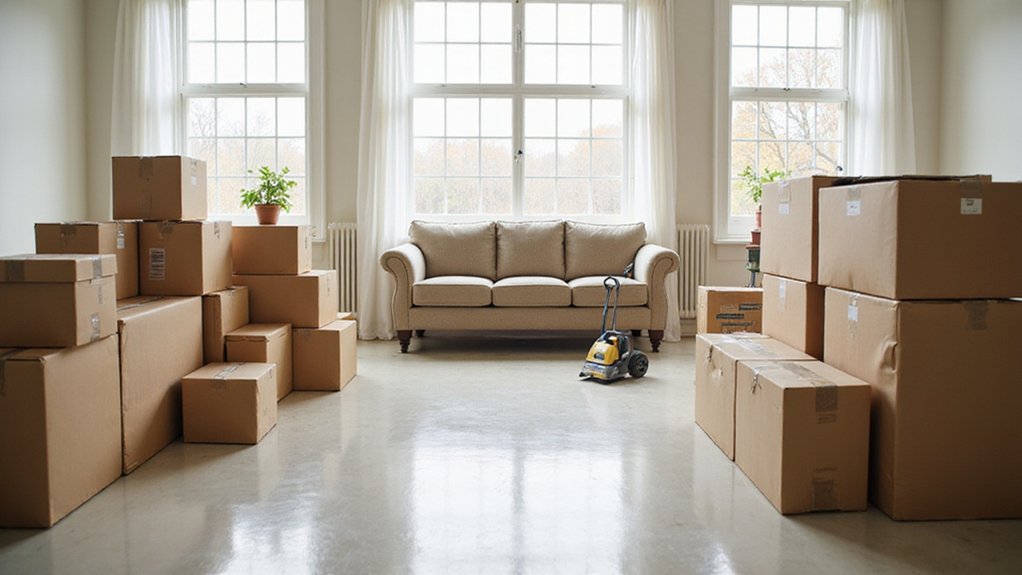Relocating can be a formidable challenge that leaves you feeling overwhelmed and stressed. But what if you could alter this potentially chaotic experience into a smooth, manageable process? By understanding and implementing strategic techniques, you'll uncover that relocating doesn't have to be a nightmare. Curious about how to make your next move effortless and organized? Let's unpack the essential strategies that will turn your moving day from a source of anxiety into an opportunity for a fresh start.
Key Takeaways
- Begin planning your move weeks or months in advance, creating a detailed timeline and breaking down tasks into manageable steps.
- Declutter and downsize your belongings by sorting items into keep, donate, sell, and discard categories to simplify your moving process.
- Invest in high-quality packing supplies like sturdy boxes, bubble wrap, and packing tape to protect your belongings during transportation.
- Pack strategically by starting with least-used rooms, labeling boxes clearly, and creating a systematic approach to organizing your items.
- Handle fragile items with extra care by individually wrapping them, using protective padding, and transporting them in the most stable areas of your vehicle.
Start Planning Early
When you're facing a move, early planning can alter a potentially stressful experience into a manageable progression. Creating a detailed schedule timeline helps you track tasks and reduce unexpected complications.
You'll want to establish priorities like sorting belongings, researching moving companies, and gathering packing supplies. By starting weeks or even months in advance, you'll give yourself breathing room to handle inevitable challenges. Breaking down the move into smaller, actionable steps prevents last-minute panic and guarantees you're prepared. For comprehensive moving support, Syracuse Moving Company offers professional services that can streamline your relocation process.
Declutter and Downsize
After establishing a thorough moving timeline, the next strategic step involves streamlining your belongings through careful decluttering and downsizing. You'll want to minimize belongings by critically evaluating necessity and letting go of items that no longer serve a purpose.
Start by sorting through each room, creating piles for keeping, donating, selling, and discarding. Be honest with yourself about what you truly need. Consider the emotional weight of possessions and the freedom that comes from traveling lighter.
Consider hiring professional moving services to assist with the logistics of relocating items you choose to keep, ensuring a smooth transition to your new space.
This process isn't just about reducing items—it's about creating space for new opportunities and experiences.
Create a Comprehensive Packing Strategy
Commence your packing process by collecting high-quality, sturdy moving boxes and essential packing supplies like bubble wrap, packing paper, and strong packing tape. Prioritize your packing timeline by starting with least-used rooms and items, systematically working through your home.
Leverage comprehensive packing checklists to track progress and ascertain nothing gets overlooked. Color-code or label boxes clearly, indicating contents and destination rooms. This strategic approach will help you stay organized, reduce stress, and make unpacking easier.
Invest in Quality Packing Supplies
Building on a strategic packing approach, selecting superior packing materials becomes your next critical step in ensuring a smooth moving experience. You'll want sturdy boxes, quality packing tape, bubble wrap, and protective padding to safeguard your belongings during transit.
Consider reusing existing materials like towels or blankets for extra cushioning, which can help reduce packaging waste. When possible, recycle cardboard boxes and packing paper after your move. Investing in reliable supplies might seem costly upfront, but it'll save you potential headaches and damaged items in the long run.
Label Everything Systematically
While moving can feel overwhelming, systematic labeling converts chaos into order. When you label boxes by room, you're creating a roadmap for your moving process. Color-coding or using clear, bold markers can help you quickly identify where each box belongs.
Label boxes by content, noting fragile items or specific categories like "kitchen utensils" or "bedroom linens". This approach saves you time during unpacking and reduces stress. By investing a few extra minutes in labeling, you'll alter a potentially chaotic move into a smooth, manageable conversion. Your future self will thank you.
Handle Fragile Items With Care
After systematically labeling your boxes, protecting delicate items becomes your next priority. You'll want to pack fragile items securely using bubble wrap, packing paper, and sturdy boxes to prevent damage during your move.
Wrap each fragile piece individually, creating a protective cushion that absorbs potential shocks. Consider double-boxing extremely delicate items for extra protection. When you transport fragile items carefully, use your vehicle's most stable areas and avoid sudden movements.
Remember that taking time to pack properly can save you from costly replacements and heartache later.
Organize Important Documents
Safeguarding your important documents is a critical step during any move, and you'll want to create a thorough organization strategy before packing begins. Collect all essential papers like birth certificates, passports, and financial records into one secure folder.
You'll need to digitize these documents by creating file backups on a cloud service or external hard drive for extra protection. Consider using waterproof and fireproof document storage containers to preserve physical copies. Keep this critical folder with you during the move, avoiding potential loss or damage during transportation.
Hire Reliable Movers
Selecting three or four reputable moving companies can greatly diminish your stress and safeguard a smooth relocation experience. Research is key when finding the right movers who'll handle your belongings with care.
Compare moving company reviews to understand their reliability and customer satisfaction. Inquire about insurance coverage to protect your precious belongings during transit. Request detailed quotes from multiple companies to ascertain fair pricing.
Pack an Essential First-Night Box
Moving can leave anyone feeling overwhelmed, which is why packing an essential first-night box isn't just smart—it's a lifeline during your shift. You'll want to personalize box contents with items that'll make your first night comfortable and stress-free. Pack this box last to ascertain easy access when you arrive.
Include toiletries, a change of clothes, chargers, medications, basic kitchen supplies, and important documents. Consider adding comfort items like a favorite blanket or pillow. Having these necessities readily available will help you adapt smoothly and feel more in control during a chaotic moving day.
Update Your Address and Utilities
Because administrative tasks can quickly become overwhelming during a move, updating your address and utilities should be a top priority. Taking proactive steps will help you shift smoothly and avoid potential service interruptions.
Notify utility providers at least two weeks before your move date. Confirm service cancellation at your current residence. Transfer or set up new utility accounts at your destination address.
Don't forget to update your address with banks, employers, and subscription services. Handling these details early will give you peace of mind and help you focus on the exciting aspects of your move.
Frequently Asked Questions
How Much Should I Tip Professional Movers?
Tip movers 10-20% of total moving costs, with $10-$20 per mover for a half-day job and $20-$40 per mover for a full-day move, based on service quality and tipping guidelines.
Can I Move Expensive or Valuable Items Myself?
You'll want to carefully secure high-value items using professional packing techniques and consider hiring professional appraisers. Trust experienced movers for irreplaceable or expensive possessions to safeguard their safe transport during your move.
What Moving Insurance Options Are Available for Homeowners?
You'll want to embark on full-value protection and released-value coverage. These moving insurance options safeguard your belongings, giving you peace of mind and financial security during your relocation journey.
How Far in Advance Should I Schedule Professional Movers?
You'll want to book movers 8-12 weeks ahead for peak season (May-September), and 4-6 weeks prior during off-peak months. Compare multiple companies, checking reviews and ensuring they match your moving timeline and specific needs.
Are There Tax Deductions for Moving Expenses?
Currently, tax deductions for moving expenses are limited. You'll only qualify if you're an active-duty military member relocating due to a permanent change of station. Other taxpayers won't receive tax credits for moving.


